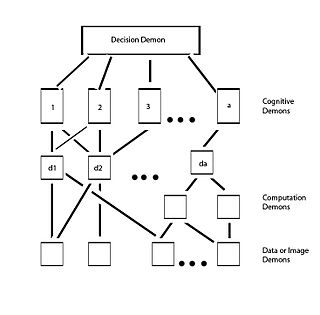
The picture superiority effect refers to the phenomenon in which pictures and images are more likely to be remembered than are words. This effect has been demonstrated in numerous experiments using different methods. It is based on the notion that "human memory is extremely sensitive to the symbolic modality of presentation of event information". Explanations for the picture superiority effect are not concrete and are still being debated, however an evolutionary explanation is that sight has a long history stretching back millions of years and was crucial to survival in the past, whereas reading is a relatively recent invention, and requires specific cognitive processes, such as decoding symbols and linking them to meaning.
The Levels of Processing model, created by Fergus I. M. Craik and Robert S. Lockhart in 1972, describes memory recall of stimuli as a function of the depth of mental processing. More analysis produce more elaborate and stronger memory than lower levels of processing. Depth of processing falls on a shallow to deep continuum. Shallow processing leads to a fragile memory trace that is susceptible to rapid decay. Conversely, deep processing results in a more durable memory trace. There are three levels of processing in this model. Structural processing, or visual, is when we remember only the physical quality of the word E.g how the word is spelled and how letters look. Phonemic processing includes remembering the word by the way it sounds. E.G the word tall rhymes with fall. Lastly, we have semantic processing in which we encode the meaning of the word with another word that is similar or has similar meaning. Once the word is perceived, the brain allows for a deeper processing.
The N400 is a component of time-locked EEG signals known as event-related potentials (ERP). It is a negative-going deflection that peaks around 400 milliseconds post-stimulus onset, although it can extend from 250-500 ms, and is typically maximal over centro-parietal electrode sites. The N400 is part of the normal brain response to words and other meaningful stimuli, including visual and auditory words, sign language signs, pictures, faces, environmental sounds, and smells.
A pseudoword is a unit of speech or text that appears to be an actual word in a certain language, while in fact it has no meaning. It is a specific type of nonce word, or even more narrowly a nonsense word, composed of a combination of phonemes which nevertheless conform to the language's phonotactic rules. It is thus a kind of vocable: utterable but meaningless.
The lexical decision task (LDT) is a procedure used in many psychology and psycholinguistics experiments. The basic procedure involves measuring how quickly people classify stimuli as words or nonwords.
Self-referential encoding is a method of organizing information in one's memory in which one interprets incoming information in relation to oneself, using one's self-concept as a background. Examples include being able to attribute personality traits to oneself or to identify recollected episodes as being personal memories of the past. The implications of self-referential processing are evident in many psychological phenomena. For example, the "cocktail party effect" notes that people attend to the sound of their names even during other conversation or more prominent, distracting noise. Also, people tend to evaluate things related to themselves more positively. For example, people tend to prefer their own initials over other letters. The self-reference effect (SRE) has received the most attention through investigations into memory. The concepts of self-referential encoding and the SRE rely on the notion that relating information to the self during the process of encoding it in memory facilitates recall, hence the effect of self-reference on memory. In essence, researchers have investigated the potential mnemonic properties of self-reference.
Memory has the ability to encode, store and recall information. Memories give an organism the capability to learn and adapt from previous experiences as well as build relationships. Encoding allows a perceived item of use or interest to be converted into a construct that can be stored within the brain and recalled later from long-term memory. Working memory stores information for immediate use or manipulation, which is aided through hooking onto previously archived items already present in the long-term memory of an individual.
The generation effect is a phenomenon whereby information is better remembered if it is generated from one's own mind rather than simply read. Researchers have struggled to account for why the generated information is better recalled than read information, but no single explanation has been sufficient to explain everything.
In cognitive psychology, the missing letter effect refers to the finding that, when people are asked to consciously detect target letters while reading text, they miss more letters in frequent function words than in less frequent, content words. Understanding how, why and where this effect arises becomes useful in explaining the range of cognitive processes that are associated with reading text. The missing letter effect has also been referred to as the reverse word superiority effect, since it describes a phenomenon where letters in more frequent words fail to be identified, instead of letter identification benefitting from increased word frequency.

Pandemonium architecture is a theory in cognitive science that describes how visual images are processed by the brain. It has applications in artificial intelligence and pattern recognition. The theory was developed by the artificial intelligence pioneer Oliver Selfridge in 1959. It describes the process of object recognition as a hierarchical system of detection and association by a metaphorical set of "demons" sending signals to each other. This model is now recognized as the basis of visual perception in cognitive science.
Sentence processing takes place whenever a reader or listener processes a language utterance, either in isolation or in the context of a conversation or a text. Many studies of the human language comprehension process have focused on reading of single utterances (sentences) without context. Extensive research has shown that language comprehension is affected by context preceding a given utterance as well as many other factors.
The logogen model of 1969 is a model of speech recognition that uses units called "logogens" to explain how humans comprehend spoken or written words. Logogens are a vast number of specialized recognition units, each able to recognize one specific word. This model provides for the effects of context on word recognition.
Indirect memory tests assess the retention of information without direct reference to the source of information. Participants are given tasks designed to elicit knowledge that was acquired incidentally or unconsciously and is evident when performance shows greater inclination towards items initially presented than new items. Performance on indirect tests may reflect contributions of implicit memory, the effects of priming, a preference to respond to previously experienced stimuli over novel stimuli. Types of indirect memory tests include the implicit association test, the lexical decision task, the word stem completion task, artificial grammar learning, word fragment completion, and the serial reaction time task.
Priming is the idea that exposure to one stimulus may influence a response to a subsequent stimulus, without conscious guidance or intention. The priming effect is the positive or negative effect of a rapidly presented stimulus on the processing of a second stimulus that appears shortly after. Generally speaking, the generation of priming effect depends on the existence of some positive or negative relationship between priming and target stimuli. For example, the word nurse might be recognized more quickly following the word doctor than following the word bread. Priming can be perceptual, associative, repetitive, positive, negative, affective, semantic, or conceptual. Priming effects involve word recognition, semantic processing, attention, unconscious processing, and many other issues, and are related to differences in various writing systems. Onset of priming effects can be almost instantaneous.
Word recognition, according to Literacy Information and Communication System (LINCS) is "the ability of a reader to recognize written words correctly and virtually effortlessly". It is sometimes referred to as "isolated word recognition" because it involves a reader's ability to recognize words individually from a list without needing similar words for contextual help. LINCS continues to say that "rapid and effortless word recognition is the main component of fluent reading" and explains that these skills can be improved by "practic[ing] with flashcards, lists, and word grids".
A context effect is an aspect of cognitive psychology that describes the influence of environmental factors on one's perception of a stimulus. The impact of context effects is considered to be part of top-down design. The concept is supported by the theoretical approach to perception known as constructive perception. Context effects can impact our daily lives in many ways such as word recognition, learning abilities, memory, and object recognition. It can have an extensive effect on marketing and consumer decisions. For example, research has shown that the comfort level of the floor that shoppers are standing on while reviewing products can affect their assessments of product's quality, leading to higher assessments if the floor is comfortable and lower ratings if it is uncomfortable. Because of effects such as this, context effects are currently studied predominantly in marketing.
The dual-route theory of reading aloud was first described in the early 1970s. This theory suggests that two separate mental mechanisms, or cognitive routes, are involved in reading aloud, with output of both mechanisms contributing to the pronunciation of a written stimulus.
Bilingual lexical access is an area of psycholinguistics that studies the activation or retrieval process of the mental lexicon for bilingual people.
The word frequency effect is a psychological phenomenon where recognition times are faster for words seen more frequently than for words seen less frequently. Word frequency depends on individual awareness of the tested language. The phenomenon can be extended to different characters of the word in non-alphabetic languages such as Chinese.
In psychology, the transposed letter effect is a test of how a word is processed when two letters within the word are switched.


